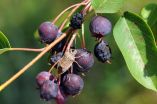(Press-News.org) DURHAM, N.C. - Researchers at Duke University School of Medicine and Brigham and Women's Hospital, Harvard Medical School have identified a mechanism that explains why some mutations can be disease-causing in one genome but benign in another.
In a study appearing June 29, 2015, in the journal Nature, the researchers compared thousands of human disease-causing mutations with the analogous sequences of some 100 animal species. They discovered non-human genomes carrying mutations that cause severe disease in humans, yet were benign in the animals.
Although generally in line with earlier observations, the scale of the findings motivated geneticists to find the explanation for this apparent mystery.
"We found many examples in which an entire species should have a serious genetic ailment, but instead were healthy," said Nicholas Katsanis, Ph.D., director of the Center for Human Disease Modeling and professor cell biology and pediatrics at Duke. "So, if we can understand how animals escape illness from such severe genetic mutations, we might have a way to make humans better.
"What we considered is that for many mutations, there must be a buffering mechanism - another mutation that protects the animal from the detrimental affects of the disease-causing mutation," Katsanis said.
The researchers considered two possible explanations: Disease suppression might be the result of one or two additional substitutions on the same gene that buffer the harmful effect of the mutation; or suppression may be caused by numerous small substitutions throughout the genome that form an aggregate "shield."
"Evolutionary theory told us that such a shield must exist, we just did not know how if would work," Katsanis said. "Now we know at least part of the answer."
The team tracked changes in protein sequence that travelled with the disease-causing mutation and were candidates for offering protection. If a species lost the "traveler", it would also have to eliminate the mutation or become extinct.
The researches tested this notion using molecular tools to identify these sites. They first engineered mutant proteins that were defective, then added secondary sites and were able to completely restore protein function.
"In the end, it looks like you can shield mutations with a single change elsewhere in the same gene, creating a single champion." Katsanis added.
With the advent of genome engineering, scientists are now introducing hundreds of different human mutations in other species to study their effects and develop new drugs. Because the effect of mutations on protein function might be dependent on the broader context of the human sequence, this approach will also lead to serious false negative conclusions, Katsanis warns.
"We are really beginning to appreciate the fundamental complexity of the human genome and genomes in general," Katsanis said. "It used to be black-and-white: mutation, bad; no mutation, good. But it's far more complex. We are now beginning to be able to compute the effect of mutations in the context of the rest of the genome. There is no question that this will improve our ability to interpret human genomes and inform clinical practice"
Co-author Shamil Sunyaev, Ph.D., professor of medicine at Brigham and Women's Hospital and Harvard Medical School, agrees that the results highlight the complexity of interpreting DNA sequences.
"Our study provides an example of the utility of comparative genomics and evolutionary models for medicine," Sunyaev said. "At the same time, it shows how data accumulated by medical geneticists can be used to better understand evolution. Beyond medicine and evolution, the logical next step would be to explain biochemical mechanisms underlying interactions between mutations."
INFORMATION:
In addition to Katsanis and Sunyaev, study authors include Daniel M. Jordan; Stephan G. Frangakis; Christelle Golzio; Chris Cassa; Joanne Kurtzberg; Task Force for Neonatal Genomics; and Erica E. Davis.
The study received funding from the National Institutes of Health (R01HD04260, R01DK072301, R01DK075972, R01 GM078598, R01 MH101244, R01 DK095721, U01 HG006500, R01EY021872) and NARSAD Young Investigator Award.
The brown marmorated stink bug has a bad reputation. And for good reason: every summer, this pest attacks crops and invades homes, causing both sizable economic losses and a messy, smelly nuisance--especially in the eastern United States. A new study by entomologists at the University of Maryland shows that these pests, known simply as stink bugs, have a strong preference for ripe fruit. Moreover, stink bugs track their favorite fruits throughout the growing season in an effort to maximize their access to food.
The study, published online June 25, 2015 in the Journal ...
PHILADELPHIA -- Since their discovery in the 1950s, transfer RNAs (tRNAs) have been best known for their role in helping the cell make proteins from messenger RNA templates. However, recent studies have led to a previously-unsuspected concept that tRNAs are not always the end product; namely, they further serve as a source of small RNAs. Now researchers have discovered a new species of tRNA-derived small RNAs that are produced only in hormonally-driven breast and prostate cancers, and which contribute to cell proliferation. The results will be published online the week ...
The warm temperature on a summer's day is often a time for relaxing, but researchers from the University of Leicester have suggested that a 'thermosensory' gene could be responsible for changes in behaviour in different climates.
The researchers from the University of Leicester's Department of Genetics have explored how the biological clock can be affected by the environment by examining the fruitfly Drosophila melanogaster, which shows 24 hour biological cycles and is used as a model organism for studies into human rhythms.
Like many humans, the fly has a 'siesta' ...
It's been difficult to explain patterns of toxic mercury in some parts of the world, such as why there's so much of the toxin deposited into ecosystems from the air in the southeastern United States, even upwind of usual sources.
A new analysis led by researchers at the University of Colorado Boulder shows that one key to understanding mercury's strange behavior may be the unexpected reactivity of naturally occurring halogen compounds from the ocean.
"Atmospheric chemistry involving bromine and iodine is turning out to be much more vigorous than we expected," said ...
A University of Oklahoma professor studying malaria mosquito interaction has discovered a new mosquito protein for the development of a new vaccine that is expected to stop the spread of the disease in areas where it is considered endemic. Malaria is transmitted by mosquitoes, and it infects millions of people in Africa, Asia and South America every year, causing a global health crisis. In addition to the local populations, U.S. military personnel stationed in these areas and travelers to these malaria-prone areas are at risk of becoming infected.
Jun Li, assistant ...
UC Santa Barbara geologist Jim Boles has found evidence of helium leakage from the Earth's mantle along a 30-mile stretch of the Newport-Inglewood Fault Zone in the Los Angeles Basin. Using samples of casing gas from two dozen oil wells ranging from LA's Westside to Newport Beach in Orange County, Boles discovered that more than one-third of the sites -- some of the deepest ones -- show evidence of high levels of helium-3 (3He).
Considered primordial, 3He is a vestige of the Big Bang. Its only terrestrial source is the mantle. Leakage of 3He suggests that the Newport-Inglewood ...
WASHINGTON (June 29, 2015) -The American College of Cardiology, Heart Rhythm Society and Society for Cardiovascular Angiography and Interventions today released a new overview on the implantation of left atrial appendage occlusion devices.
The implantation of left atrial appendage occlusion devices may lower the risk of stroke in patients with atrial fibrillation. As new devices are developed, it is anticipated that the use of left atrial appendage occlusion technologies in clinical practice will expand. The authors of the paper urge that the new technology should be ...
Stringing together meaningless sounds to create meaningful signals was previously thought to be the preserve of humans alone, but a new study, publishing June 29th in the Open Access journal PLOS Biology, has revealed that babbler birds are also able to communicate in this way.
Researchers at the Universities of Exeter and Zurich discovered that the chestnut-crowned babbler - a highly social bird found in the Australian Outback - has the ability to convey new meaning by rearranging the meaningless sounds in its calls. This babbler bird communication is reminiscent of ...
LAKEVILLE-MIDDLEBORO, Mass., (June 29, 2015) - A new study (1) reveals that drinking low-calorie cranberry juice cocktail may help lower the risk of chronic diseases that rank among the leading causes of death worldwide, including heart disease, diabetes and stroke. The finding is welcome news considering the World Health Organization estimates the trio of diseases annually claim 15.6 million lives around the globe (2). These illnesses are among the most common and costly health conditions, but fortunately, they are also among the most preventable through dietary intervention. ...
An overview and analysis of the factors underlying the recent Middle East Respiratory Syndrome coronavirus (MERS-CoV) outbreak in Korea has been published online ahead of print in the American Thoracic Society's American Journal of Respiratory and Critical Care Medicine.
"On 20 May 2015, the Republic of Korea confirmed the first case of MERS-CoV infection in a 68 year old male who had returned to Seoul after traveling to 4 countries in the Middle East," write co-authors David S Hui, MD, of the Chinese University of Hong Kong, and Malik Peiris, DPhil, of the University ...


